Experimental and Numerical Simulation Studies on the Synergistic Design of Gas Injection and Extraction Reservoirs of Condensate Gas Reservoir-Based Underground Gas Storage
Abstract
:1. Introduction
2. Overview of the Study Area
3. Gas Injection EOR-Storage Coordination
4. Multiple Rounds of Drive-By Capacity Expansion Experiments
4.1. Experimental Principles
4.2. Experimental Materials and Methods
4.2.1. Experimental Condition
4.2.2. Experimental Materials
Experimental Core
Condensate Gas
Condensate Oil
Formation Water
4.2.3. Experimental Equipment
4.2.4. Experimental Methods
- At normal temperature and pressure, first fully saturate the core with formation water (condensate), then use the replacement pump to pass the formation water/condensate through the rock samples at a specified pressure or flow rate until the pressure difference and flow rate between the inlet and outlet of the replacement rock samples stabilises. Then, measure the permeability of the water (gas) phase and the oil phase three times in succession with a relative deviation of less than 3% and use this water (gas) phase and oil phase permeability as the base value for the relative permeability of water–oil (gas-oil) and oil–water (oil-gas). This water (gas) phase and oil phase permeability is used as the base value for the water-oil (gas-oil) and oil-water (oil-gas) relative permeabilities;
- When determining the relative permeability of oil and gas, use the oil drive water (gas drive oil) method to determine the bound water (residual oil), drive until no water (oil) is produced or the oil drive multiplier reaches 20 times the pore volume or more, record the amount of water (oil) driven out, and calculate the oil saturation (gas saturation) and bound water saturation (residual oil saturation) of the rock samples;
- The initial pressure differential should ensure that the end effect can be overcome without creating turbulence;
- Adjust the outlet volume metering system, start the water drive oil (oil drive gas), and record the replacement pressure and liquid production at each moment;
- Carry out the gas-drive-oil (gas-drive-water) test to the residual oil (residual water) state, determine the effective permeability of the oil (gas) phase in the residual state, and then terminate the displacement test;
- Conduct experiments on oil-driven water (gas-driven oil) using the experimental process and methods and procedures consistent with water-driven oil (oil-driven gas);
- This cycle is repeated for five rounds of oil–water (oil and gas) mutual propulsion, and during each round of propulsion, the liquid production at the exit end of the rock sample at each moment, the pressure difference between the two ends, and other data are recorded;
- Calculate the relative permeability of the gas and oil phases and the gas and oil saturation at any time in the core according to Darcy’s formula, the JBN method [25], or the Jones graphical method [26], respectively, and plot the relative permeability curves of oil and gas. In this case, the formula for determining the relative permeability of two-phase fluids in rock is as follows:
4.3. Experimental Results and Analysis
4.3.1. Oil–Water Mutual Drive
4.3.2. Oil and Gas Interdrive
4.4. Multi-Rotation Drive-By Expansion Analysis
5. Numerical Simulation Studies
5.1. Numerical Modelling
5.2. History Matching
5.3. Programme Simulation
5.4. Analysis of the Results
- (1)
- The entire area of the pure gas zone can be used as storage capacity;
- (2)
- Considering the risk of water intrusion on the construction of gas storage facilities, the current utilisation rate of movable storage capacity in the waveable area below the gas–water interface is about 50 percent.
6. Conclusions
- (1)
- After several rounds of oil–water mutual drive, the residual oil saturation of both high-permeability rock samples and low-permeability rock samples showed a decreasing trend; meanwhile, the bound water saturation increased, and the oil–water two-phase zone did not change much, but the higher the absolute permeability of the core, the wider the two-phase co-permeability zone. After several rounds of oil and gas mutual drive, the residual oil saturation of the high-permeability rock samples and low-permeability rock samples showed a decreasing trend, while the residual gas saturation increased but with a small amplitude. The oil and gas two-phase zone did not change much, but the overall trend shows a small increase; the higher the absolute permeability of the core, the wider the range of the two-phase co-seepage zone.
- (2)
- After multiple rounds of replacement, the oil-phase flow capacity can be effectively improved and the injection and recovery capacity can be enhanced, thereby increasing the condensate recovery rate and increasing the reservoir capacity. The reservoir capacity of the high-permeability rock samples increased by approximately 4.84%, and the reservoir capacity of the low-permeability rock samples increased by approximately 7.26%.
- (3)
- By numerically modelling the reservoir operation scheme, the reservoir capacity at the end of the simulation period reached 6.1 × 108 m3, and the reservoir capacity was enlarged by 7.02%, which is close to the experimental results, indicating that condensate extraction can indeed be effectively improved and the reservoir capacity enlarged by multiple rounds of injection.
Author Contributions
Funding
Data Availability Statement
Conflicts of Interest
References
- Lawal, K.A.; Ovuru, M.I.; Eyitayo, S.I.; Matemilola, S.; Adeniyi, A.T. Underground Storage as a Solution for Stranded Associated Gas in Oil Fields. J. Pet. Sci. Eng. 2017, 150, 366–375. [Google Scholar] [CrossRef]
- Hassan, A.; Abdalla, M.; Mahmoud, M.; Glatz, G.; Al-Majed, A.; Al-Nakhli, A. Condensate-Banking Removal and Gas-Production Enhancement Using Thermochemical Injection: A Field-Scale Simulation. Processes 2020, 8, 727. [Google Scholar] [CrossRef]
- He, X.; Huang, S.; Sun, C.; Xu, J.; Zhang, X.; Yang, X. Gas-water Relative Permeability Variation in Multi-cycle Injection/production of Underground Gas Storage in Flooded Depleted Gas Reservoir. Oil Gas Storage Transp. 2015, 34, 150–153. [Google Scholar]
- Du, S.; Bai, M.; Shi, Y.; Zha, Y.; Yan, D. A Review of the Utilization of CO2 as a Cushion Gas in Underground Natural Gas Storage. Processes 2024, 12, 1489. [Google Scholar] [CrossRef]
- Gao, G.; Liu, W.; Zhu, S.; He, H.; Wang, Q.; Sun, Y.; Xiao, Q.; Yang, S. Discussion on the Reconstruction of Medium/Low-Permeability Gas Reservoirs Based on Seepage Characteristics. Processes 2022, 10, 756. [Google Scholar] [CrossRef]
- Ma, X.; Zhao, P. Practical Techniques for Underground Gas Storage Design; Petroleum Industry Press: Beijing, China, 2009. [Google Scholar]
- Shen, R.; Tian, L.; Yuan, G.; Wang, T. Research and Practice of Underground Gas (Oil) Storage Engineering Technology; Petroleum Industry Press: Beijing, China, 2009. [Google Scholar]
- Huaxia Industrial Economy Research Institute. China Underground Gas Storage Industry Market Development Status and Investment Planning Recommendation Report, 2023–2029; Huaxia Industrial Economy Research Institute: Beijing, China, 2023. [Google Scholar]
- Yan, Z.; Wang, Z.; Wu, F.; Lyu, C. Stability Analysis of Pingdingshan Pear-Shaped Multi-Mudstone Interbedded Salt Cavern Gas Storage. J. Energy Storage 2022, 56, 105963. [Google Scholar] [CrossRef]
- Ma, X.; Zhen, D.; Shen, R.; Wang, C.; Luo, J.; Sun, J. Key Technologies and Practice for Gas Field Storage Facility Construction of Complex Geological Conditions in China. Pet. Explor. Dev. 2018, 45, 489–499. [Google Scholar] [CrossRef]
- Zhao, L.; Zhang, Y.; He, Y.; Shi, J.; Wang, X.; Song, J.; Yu, H. Consistency Checks for Pressure-Volume-Temperature Experiment of Formation Oil and Gas at High Temperature. Processes 2023, 11, 2727. [Google Scholar] [CrossRef]
- Jiao, G.; Zhu, S.; Xie, F.; Yang, S.; Xiang, Z.; Xu, J. Study of the Characterisation Method of Effective Two-Phase Seepage Flow in the Construction of Gas Storage Reservoirs. Energies 2022, 16, 242. [Google Scholar] [CrossRef]
- Barrufet, M.A.; Bacquet, A.; Falcone, G. Analysis of the Storage Capacity for CO2 Sequestration of a Depleted Gas Condensate Reservoir and a Saline Aquifer. J. Can. Pet. Technol 2010, 49, 23–31. [Google Scholar] [CrossRef]
- Brannon, A.W. Prediction of The Effects of Compositional Mixing in a Reservoir on Conversion to Natural Gas Storage. Ph.D. Thesis, West Virginia University, Morgantown, WV, USA, 2011. [Google Scholar]
- Rouhbakhsh Arfaee, M.I.; Sedaee Sola, B. Investigating the Effect of Fracture–Matrix Interaction in Underground Gas Storage Process at Condensate Naturally Fractured Reservoirs. J. Nat. Gas Sci. Eng. 2014, 19, 161–174. [Google Scholar] [CrossRef]
- Deng, P.; Chen, Z.; Peng, X.; Wang, J.; Zhu, S.; Ma, H.; Wu, Z. Optimized Lower Pressure Limit for Condensate Underground Gas Storage Using a Dynamic Pseudo-Component Model. Energy 2023, 285, 129505. [Google Scholar] [CrossRef]
- Wang, J.; Shi, L.; Zhang, Y.; Zhang, K.; Li, C.; Chen, X.; Sun, J.; Qiu, X. Simulation of Petroleum Phase Behavior in Injection and Production Process of Underground Gas Storage in a Gas Reservoir. Pet. Explor. Dev. 2022, 49, 1386–1397. [Google Scholar] [CrossRef]
- Long, K.; Tang, Y.; He, Y.; Luo, Y.; Hong, Y.; Sun, Y.; Rui, Z. Full-Cycle Enhancing Condensate Recovery-Underground Gas Storage by Integrating Cyclic Gas Flooding and Storage from Gas Condensate Reservoirs. Energy 2024, 293, 130724. [Google Scholar] [CrossRef]
- Song, R.; Wang, S.; Pei, G.; Liu, J. Study on Multi-cycle Gas-water Displacing Mechanism in Underground Gas Storage of Low-permeability Reservoir Based on PNM. Energy Storage 2024, 6, e643. [Google Scholar] [CrossRef]
- Jiang, T.; Wang, J.; Wang, Z.; Zhou, D. Practice and Understanding of Collaborative Construction of Underground Gas Storage and Natural Gas Flooding. Nat. Gas Ind. 2021, 41, 66–74. [Google Scholar]
- Yang, J.; Luo, M.; Peng, H.; Sun, C.; Yang, L.; Wang, H. Economic Evaluation on Collaborative Constructing Gas Injection EOR and Strategic Gas Storage: Examples from an Oil Reservoirs, Tarim Oilfield: An Example from an Oil Reservoirs in Tarim Oilfield. Nat. Gas Technol. Econ. 2020, 14, 72–78. [Google Scholar]
- Mi, L.; Zeng, D.; Liu, H.; Guo, Y.; Zhang, G.; Chen, M.; Zhang, J. Parameter Design for Collaborative Gas Storage Construction of Gas Injection and Production in Gas Condensate Reservoirs with Oil Rings. In Proceedings of the 2nd Annual China Natural Gas Development Technology Conference, Qingdao, China, September 2023; p. 1. [Google Scholar]
- He, X.; Huang, Z.; Lian, N.; Chen, R.; Fu, Y.; Zhou, W. Key Technologies for Enhancing the Recovery of Condensate Gas Reservoirs by Gas Injection-Storage Coordination. Nat. Gas Ind. 2023, 43, 86–95. [Google Scholar]
- Liu, H.; Xie, B.; Xin, X.; Zhao, H.; Liu, Y. Investigation on the Extent of Retrograde Condensation of Qianshao Gas Condensate Reservoir Using PVT Experiments and Compositional Reservoir Simulation. Processes 2024, 12, 503. [Google Scholar] [CrossRef]
- Johnson, E.F.; Bossler, D.P.; Bossler, V.O.N. Calculation of Relative Permeability from Displacement Experiments. Trans. AIME 1959, 216, 370–372. [Google Scholar] [CrossRef]
- Jones, S.C.; Roszelle, W.O. Graphical Techniques for Determining Relative Permeability from Displacement Experiments. J. Pet. Technol. 1978, 30, 807–817. [Google Scholar] [CrossRef]
- Pan, H.; Liu, F.; Liu, C.; Pan, W. Gas Injection Flooding for EOR and Its Impacts on The Proposed Underground Gas Storage Capacity: A Case Study from the Xinggu 7 Buried Hill Oil Reservoir in The Western Liaohe Depression. Nat. Gas Ind. 2014, 34, 93–97. [Google Scholar]
- Fan, J.; Wu, Z.; Yu, S.; Zhou, D.; Yan, G.; Qang, C. Factors Influencing Effective Storage Capacity of Abnormally-High-Pressure Water-Containing Condensate Gas Reservoirs. Xinjiang Pet. Geol. 2022, 43, 463–467. [Google Scholar]
- Tananykhin, D.S.; Struchkov, I.A.; Khormali, A.; Roschin, P.V. Investigation of the Influences of Asphaltene Deposition on Oilfield Development Using Reservoir Simulation. Pet. Explor. Dev. 2022, 49, 1138–1149. [Google Scholar] [CrossRef]
- Zhang, Z. Study on Seepage Mechanism and Application in Gas Condensate Reservoir Reconstruction and Storage; Southwest Petroleum University: Nanchong, China, 2018. [Google Scholar]
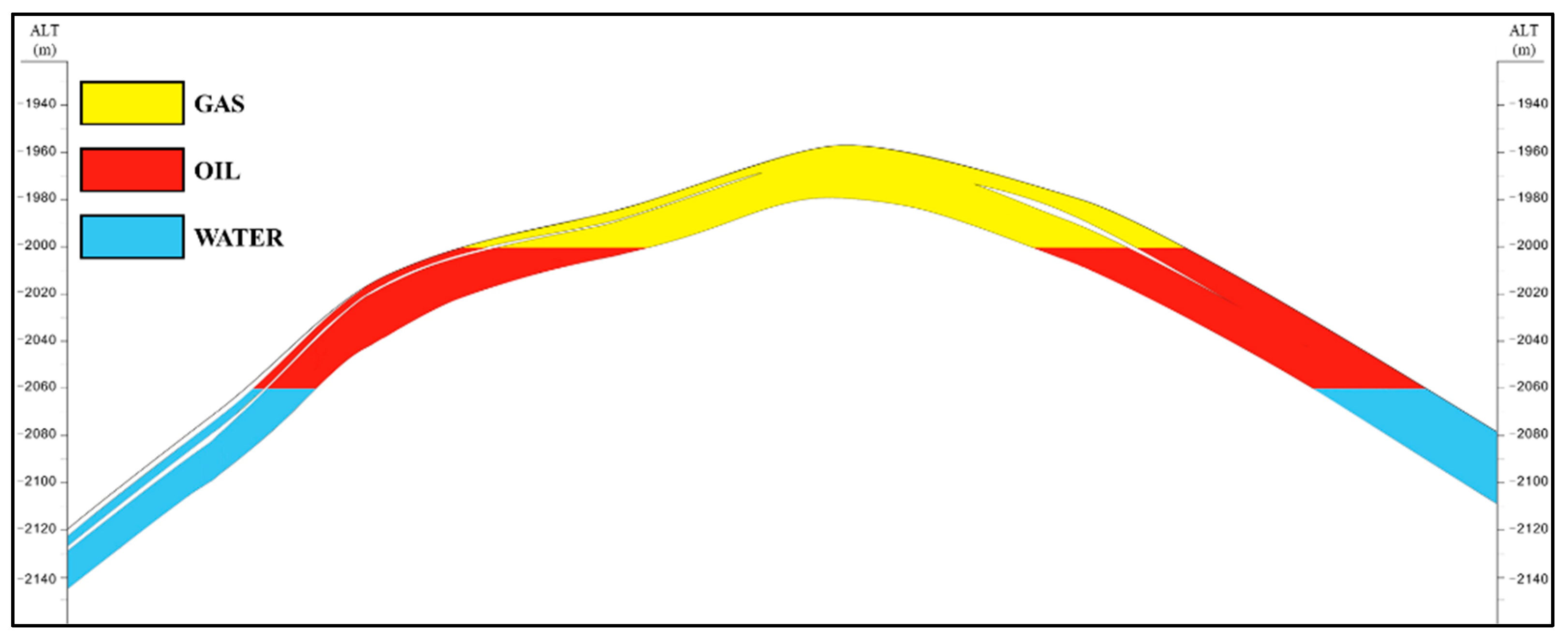


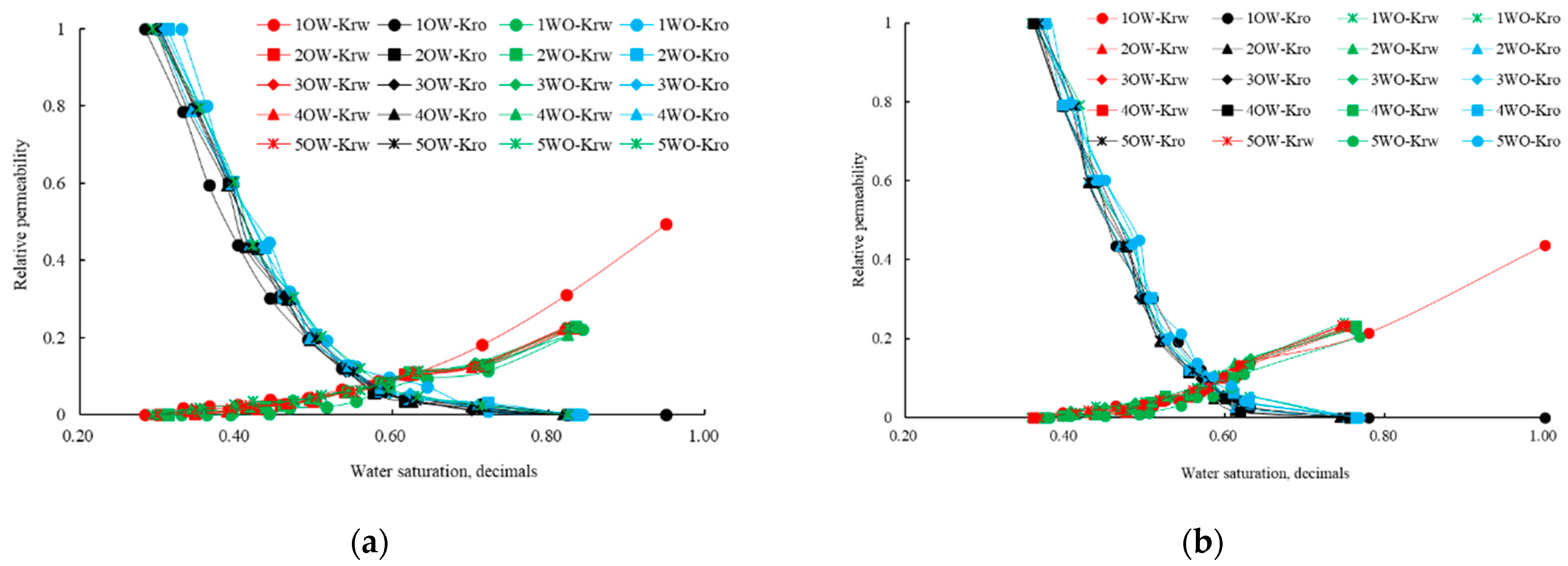
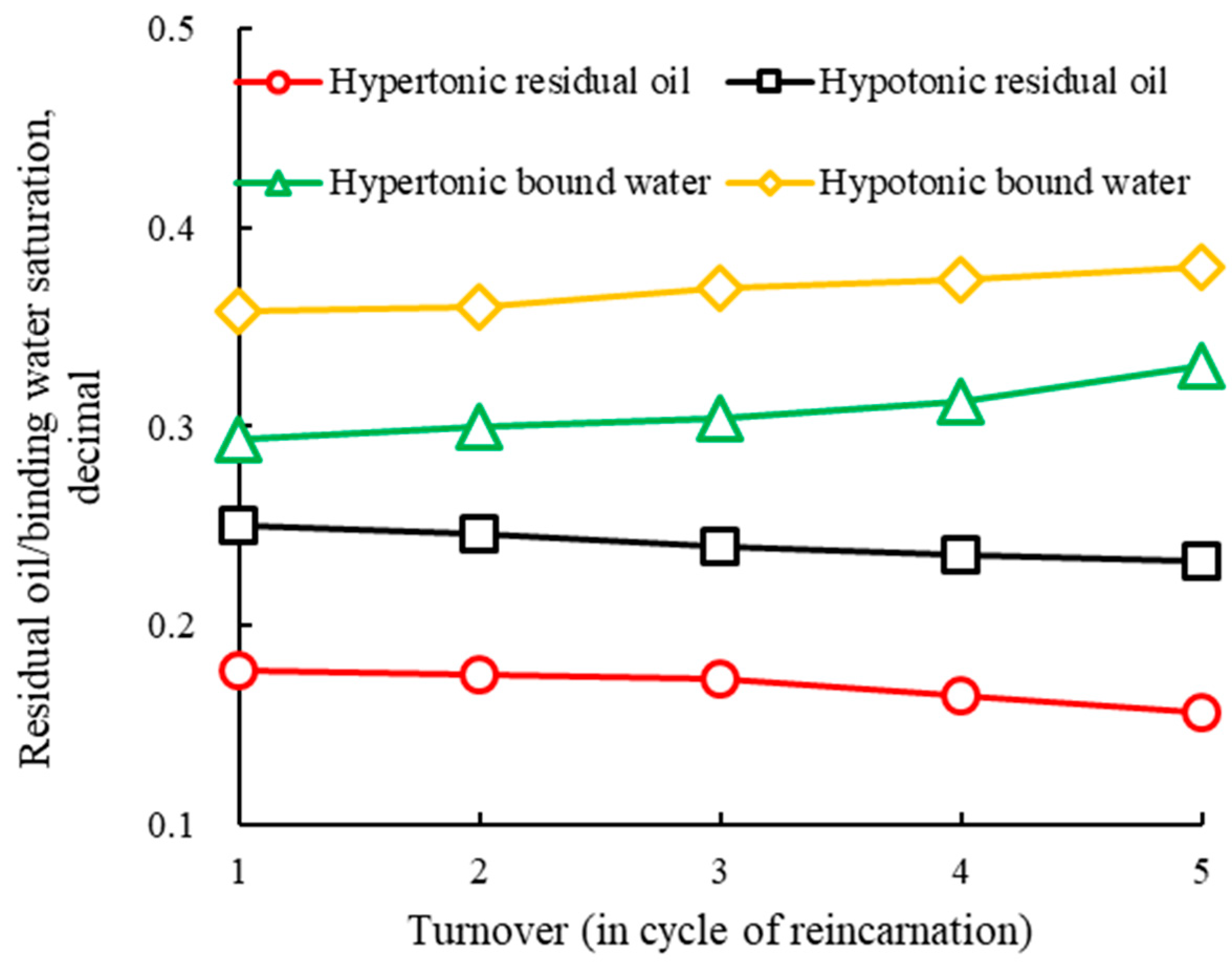



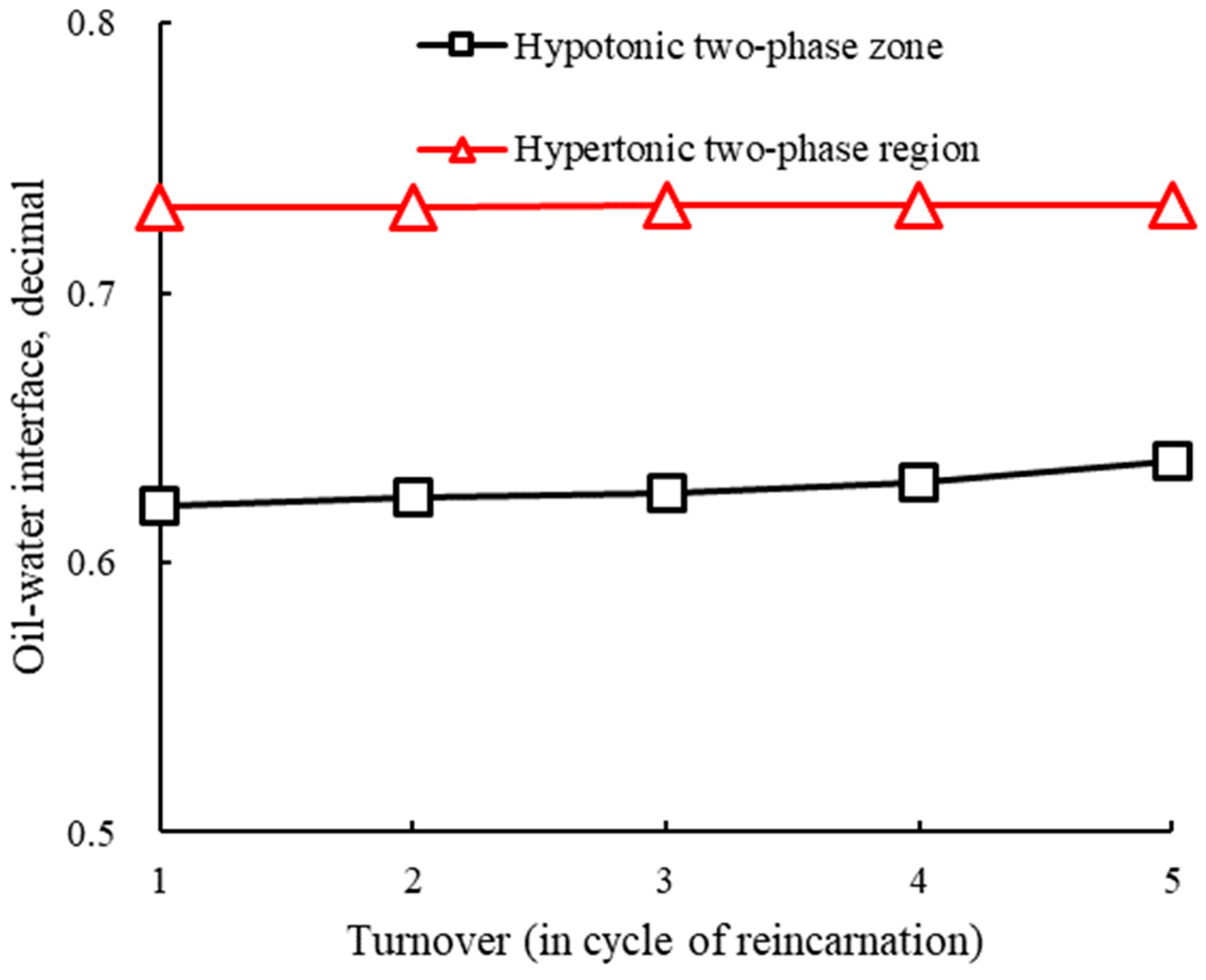
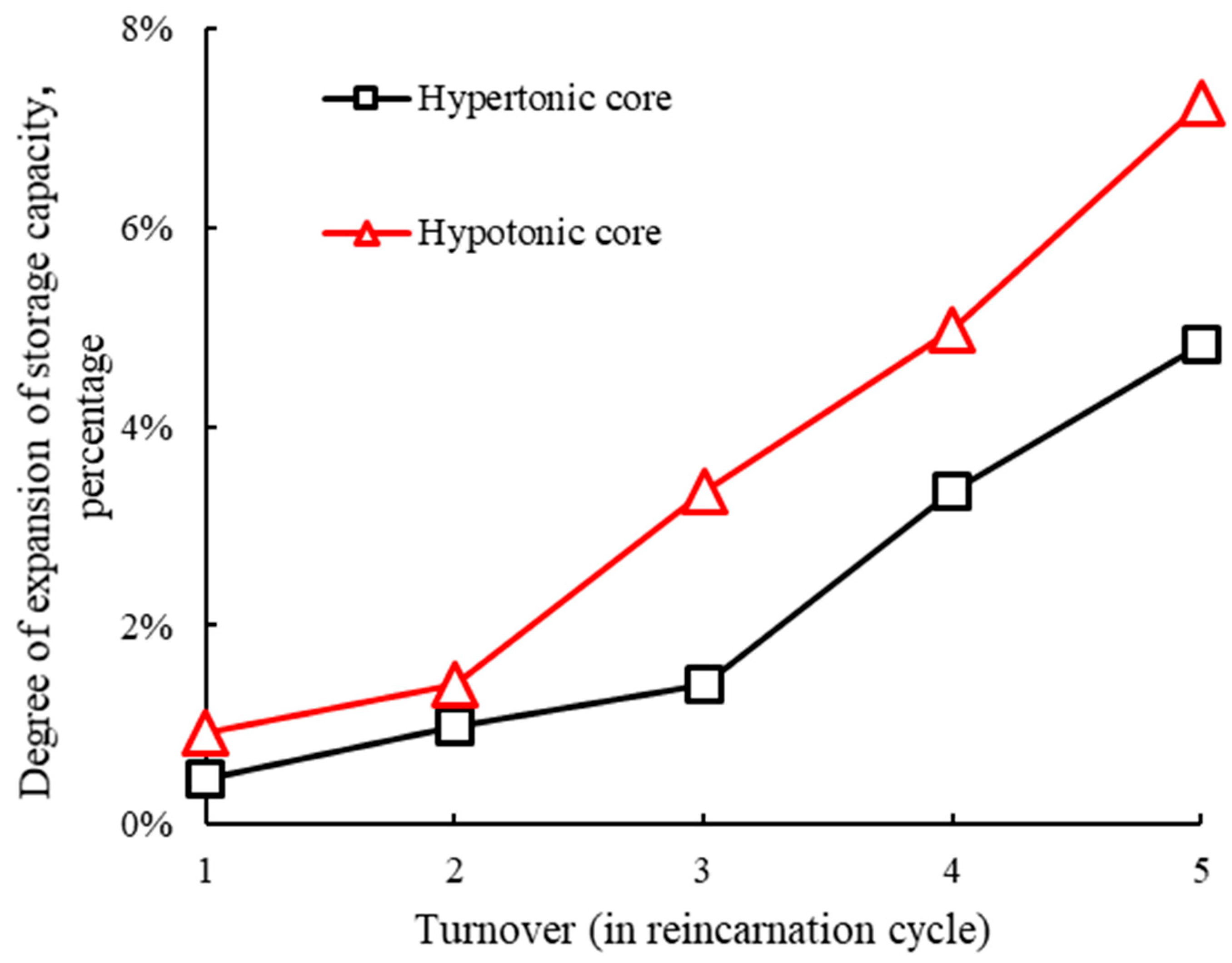


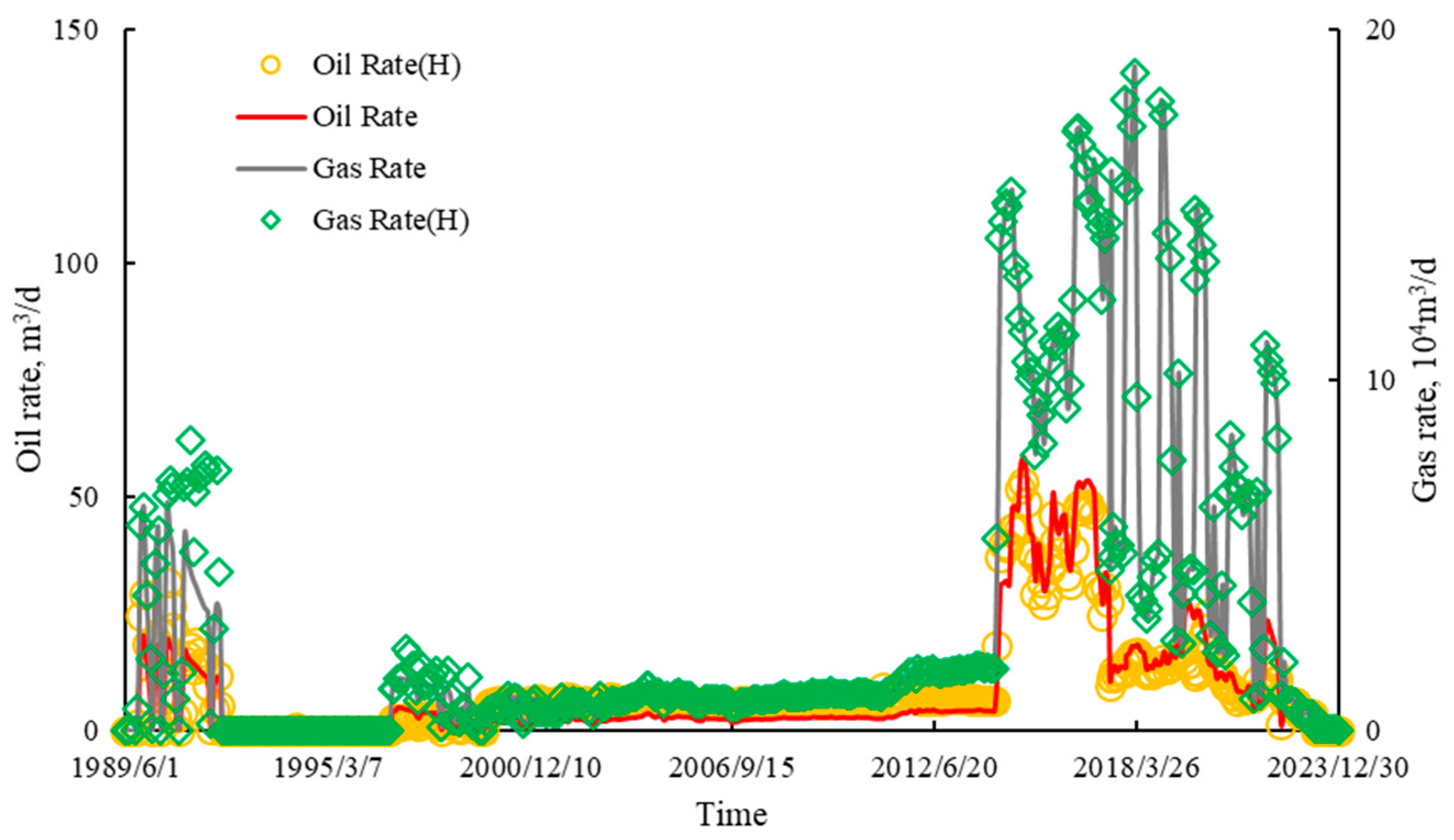
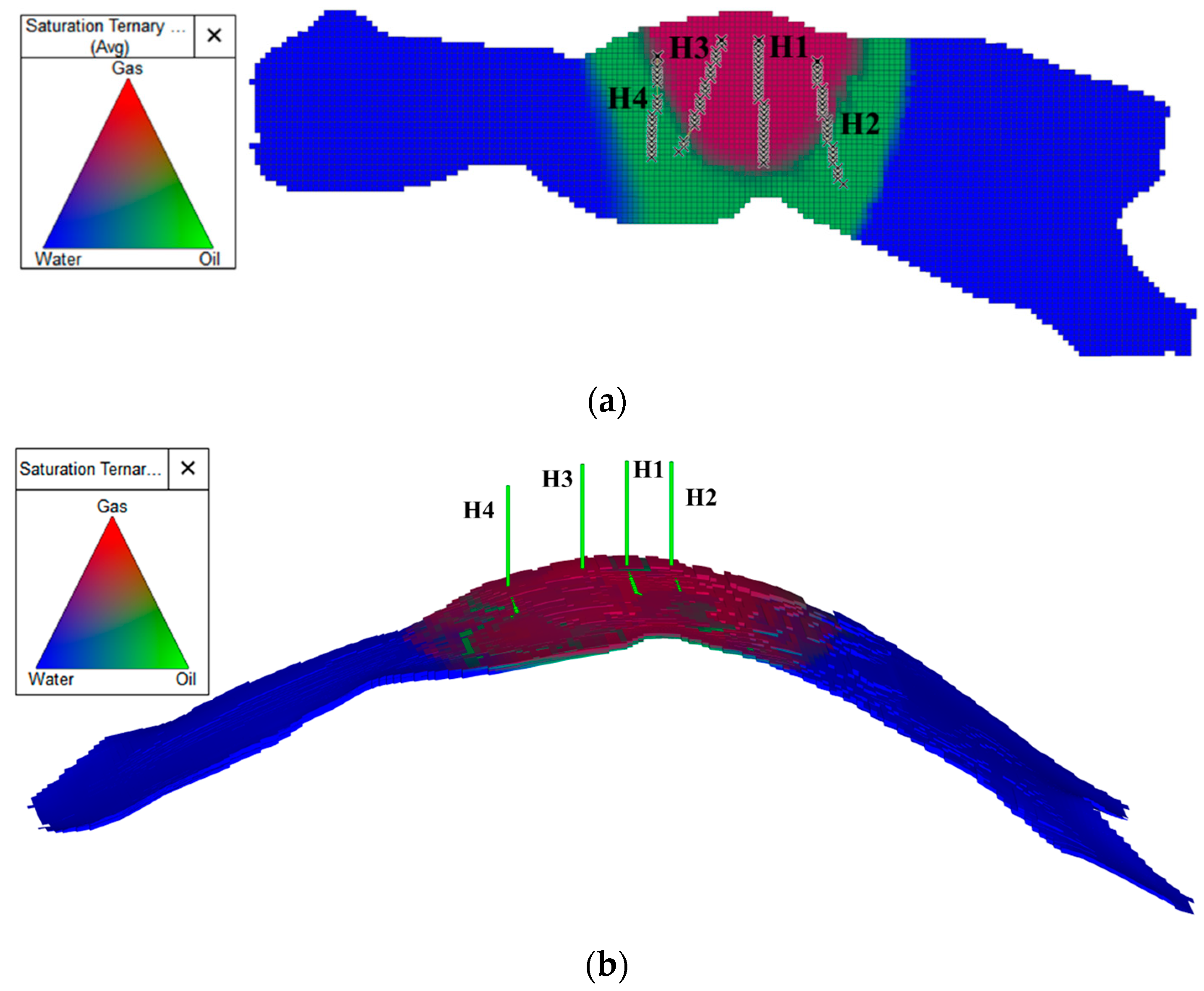
| Core Number | Lengths (cm) | Calibre (cm) | Appearance Volume (cc) | Densities (g/cm3) | Porosity (%) | Permeability (mD) |
|---|---|---|---|---|---|---|
| 1 | 7.547 | 2.425 | 34.839 | 2.234 | 13.16 | 45.27 |
| 2 | 5.356 | 2.421 | 24.643 | 2.231 | 15.25 | 60.64 |
| 3 | 5.784 | 2.427 | 26.745 | 2.193 | 15.97 | 88.75 |
| 4 | 7.457 | 2.419 | 34.254 | 2.237 | 14.32 | 78.34 |
| 5 | 6.119 | 2.429 | 28.340 | 2.239 | 14.48 | 62.29 |
| Composition | Mole Fraction/% | Composition | Mole Fraction/% |
|---|---|---|---|
| CO2 | / | nC5 | 0.354 |
| N2 | 2.743 | C6 | 0.253 |
| C1 | 84.254 | C7 | 0.180 |
| C2 | 6.880 | C8 | 0.241 |
| C3 | 2.094 | C9 | 0.219 |
| iC4 | 0.365 | C10 | 0.156 |
| nC4 | 0.813 | C11+ | 0.314 |
| iC5 | 1.134 |
| Composition | Mole Fraction/% | Composition | Mole Fraction/% |
|---|---|---|---|
| CO2 | 0.98 | nC5 | 2.9 |
| N2 | 0.18 | C6 | 6.83 |
| C1 | 43.73 | C7 | 5.49 |
| C2 | 3.06 | C8 | 5.81 |
| C3 | 1.35 | C9 | 4.77 |
| iC4 | 0.38 | C10 | 3.79 |
| nC4 | 0.93 | C11+ | 18.36 |
| iC5 | 1.44 |
| Relative Density (mg/L) | Cationic | Anionic | TDS | Water-Based | ||||
|---|---|---|---|---|---|---|---|---|
| K+, Na+ | Ca2+ | Mg2+ | Cl− | SO42− | HCO3− | |||
| 1.0975 | 48,457 | 8545 | 1264 | 92,933 | 680 | 93 | 139,567 | CaCl2 |
Disclaimer/Publisher’s Note: The statements, opinions and data contained in all publications are solely those of the individual author(s) and contributor(s) and not of MDPI and/or the editor(s). MDPI and/or the editor(s) disclaim responsibility for any injury to people or property resulting from any ideas, methods, instructions or products referred to in the content. |
© 2024 by the authors. Licensee MDPI, Basel, Switzerland. This article is an open access article distributed under the terms and conditions of the Creative Commons Attribution (CC BY) license (https://creativecommons.org/licenses/by/4.0/).
Share and Cite
Geng, J.; Zhang, H.; Yue, P.; Qu, S.; Wang, M.; Chen, B. Experimental and Numerical Simulation Studies on the Synergistic Design of Gas Injection and Extraction Reservoirs of Condensate Gas Reservoir-Based Underground Gas Storage. Processes 2024, 12, 2668. https://doi.org/10.3390/pr12122668
Geng J, Zhang H, Yue P, Qu S, Wang M, Chen B. Experimental and Numerical Simulation Studies on the Synergistic Design of Gas Injection and Extraction Reservoirs of Condensate Gas Reservoir-Based Underground Gas Storage. Processes. 2024; 12(12):2668. https://doi.org/10.3390/pr12122668
Chicago/Turabian StyleGeng, Jie, Hu Zhang, Ping Yue, Simin Qu, Mutong Wang, and Baoxin Chen. 2024. "Experimental and Numerical Simulation Studies on the Synergistic Design of Gas Injection and Extraction Reservoirs of Condensate Gas Reservoir-Based Underground Gas Storage" Processes 12, no. 12: 2668. https://doi.org/10.3390/pr12122668
APA StyleGeng, J., Zhang, H., Yue, P., Qu, S., Wang, M., & Chen, B. (2024). Experimental and Numerical Simulation Studies on the Synergistic Design of Gas Injection and Extraction Reservoirs of Condensate Gas Reservoir-Based Underground Gas Storage. Processes, 12(12), 2668. https://doi.org/10.3390/pr12122668






